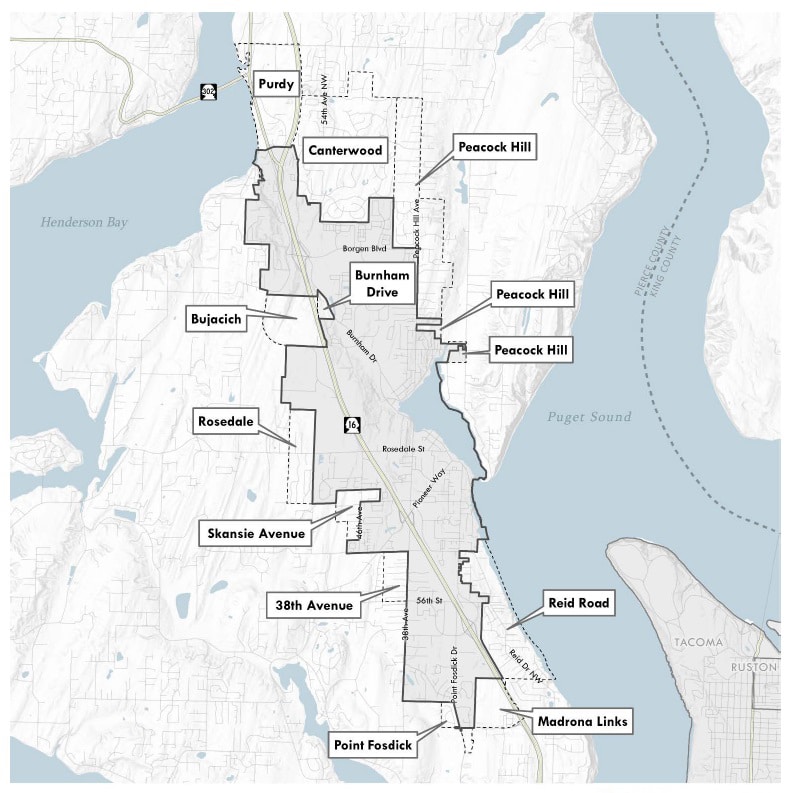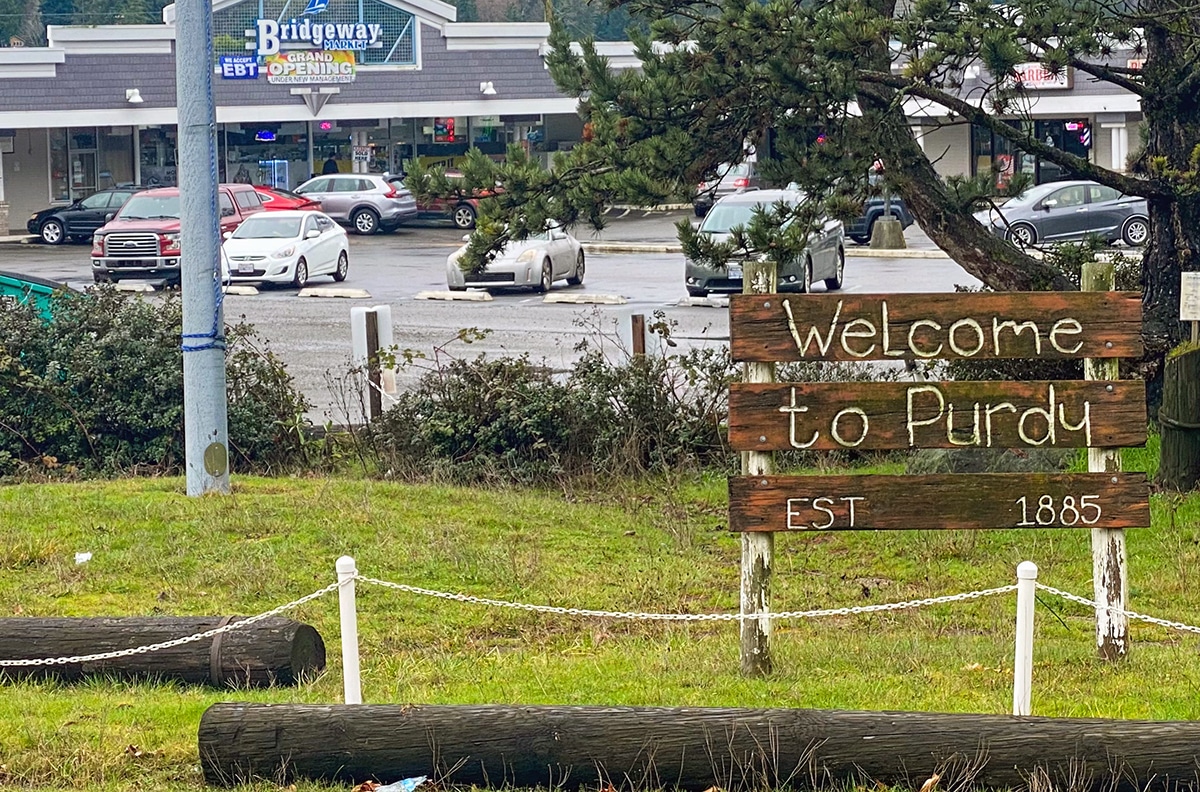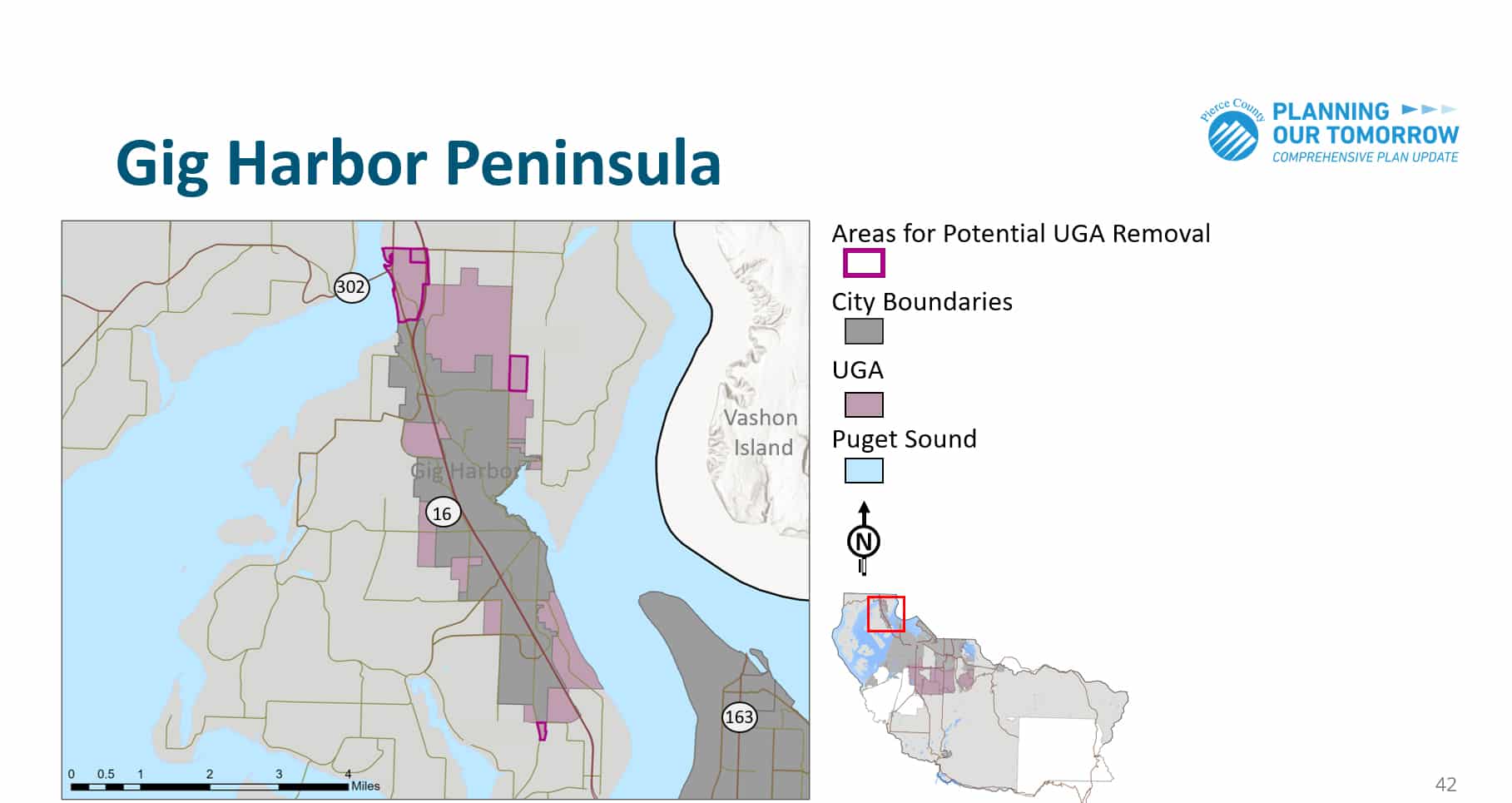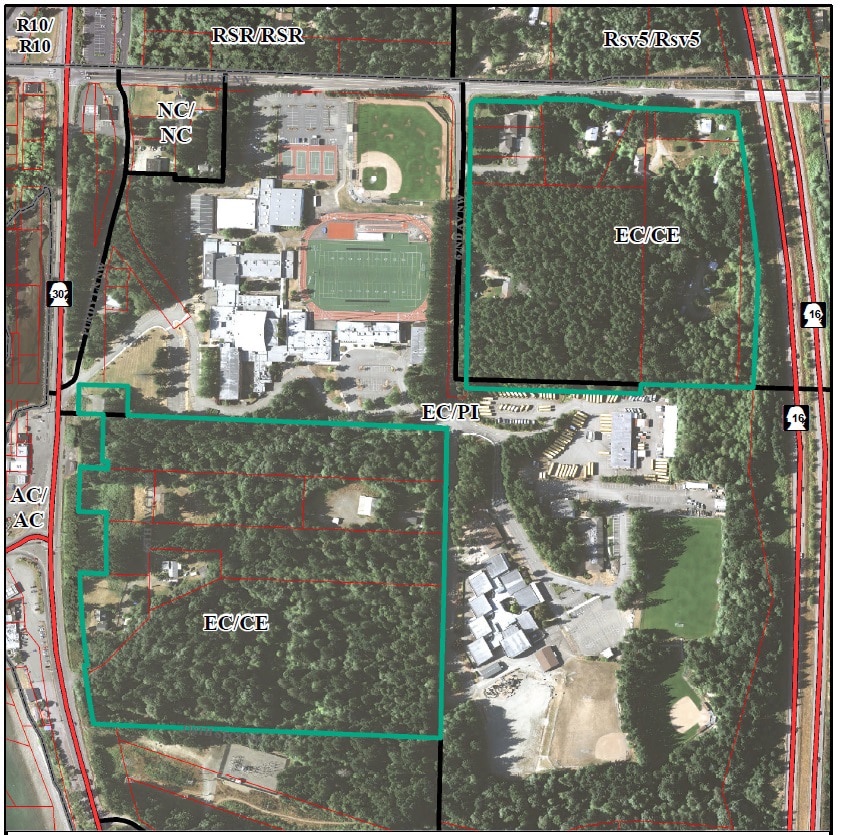Business Community Environment
Pierce County weighs stripping urban growth designation from Purdy
If Purdy ever truly dreamed of an urban future, that possibility may be slipping away.
The tiny agglomeration of businesses, schools, homes and utility company maintenance yards at the head of Henderson Bay, just over Gig Harbor’s northern border, has long been designated an urban growth area (UGA) under the Pierce County Comprehensive Plan.
That’s a place intended to become more city-like. Zoning in UGAs aims to attract development accompanied by urban infrastructure. Under state growth management law, UGAs are annexation targets for neighboring cities (in Purdy’s case, Gig Harbor).
But in the comp plan update underway this year, Pierce County may for the first time strip UGA status from some areas — including Purdy and two smaller slices of unincorporated land next to Gig Harbor.

This map shows Gig Harbor’s Urban Growth Area, marked by dotted lines. Urban growth areas allow higher density development than rural unincorporated land and are considered potential annexation targets for adjoining cities. Source: Berk Consulting (commissioned by the city of Gig Harbor.)
Developer wants to keep Purdy in UGA
For Purdy property owners, this could hurt financially when their land is downzoned and the likelihood of extending services like public sewer, water and stormwater management to serve development there evaporates in the wake of urban growth area retraction.
One of the UGA’s largest landowners, Gig Harbor-based Rush Companies, controls 38 acres in Purdy and is working with owners of 6 adjacent acres, all to the south and east of Peninsula High School. Current Mixed Use Development (MUD) zoning allows a mix of commercial and single- and multi-family residential development on this property. But with UGA retraction, the 44 acres would be reclassified as rural, said Rush Companies Development Manager Steve Yester.
The company is lobbying Pierce County to recognize what Rush says are flaws in the rationale being used to justify retracting Purdy’s UGA status. Yester said the firm feels “whipsawed” about the proposed downzoning, since Pierce County OK’d the upzone to MUD of Rush’s Purdy holdings just 7 years ago, allowing higher density development.
Purdy already looks and feels like a small city, with “an impressive range of commercial uses,” Yester wrote in a letter to the county. Those include two gas stations; four restaurants; grocery stores and other retail businesses; professional services; utility company offices; and maintenance yards. Those business support hundreds of jobs in the area.
State Routes 16 and 302 define Purdy’s east and west edges and there’s even a Sound Transit Park & Ride as a starting point for extending urban-level mass transit, he noted.
“There is nothing rural about [Purdy] and it would not be desirable or appropriate for rural uses,” he wrote.

Purdy
Small-town feel
But some residents are cheering on the idea of Purdy no longer being an urban growth area.
Wendy Ferrell, a fifth-generation Purdy-ite who lives on land homesteaded by her great-grandfather, said the retraction of UGA status is exactly what the community needs to retain its small-town feel and protect its abundant natural features.
Limiting traffic on thoroughfares like Purdy Drive and 144th Street NW would protect Peninsula High School and Purdy Elementary School students who walk and bike there, she told attendees of a briefing on the comprehensive plan update at a Key Peninsula Land Use Advisory Commission meeting on Jan. 25.
Ratcheting down the development allowed in Purdy will help safeguard the area’s environmental resources, including Burley Lagoon and Henderson Bay shoreline and salmon-bearing Purdy Creek, said Ferrell, who is also on the board of community group Friends of Burley Lagoon.
Purdy “never was an urban center and it’s not one now,” Ferrell said.
“I think the footprint of Purdy has really remained the same since the early ’90s,” when the area was first made a UGA, she said. “Everything is existing just fine as-is. We don’t need more.”
A long process
Purdy’s pro- and anti-urbanization advocates will have months of hearings, briefings and other opportunities to make their cases as the comp plan update wends its way to completion. The goal is to map the best path for growth in unincorporated Pierce County over the next 20 years.
The county floated the idea of Urban Growth Area retraction in the comp plan’s draft environmental impact statement (EIS), which lays out three alternative paths toward accommodating growth.
One of these, called Alternative 3, intends to “end the trend” of existing land use and growth patterns by rapidly shifting growth, transportation, and climate policies to create “high-capacity transit” areas around Pierce County.
Alternative 3 identifies a surplus of UGA land in Pierce County and says the county should consider trimming 2,531 acres from these areas — including Purdy.

This Pierce County map shows Gig Harbor’s city limits, current UGA boundaries, and areas proposed for removal from UGA boundaries.
(Alternative 3 lists two other parts of Gig Harbor’s urban growth area for possible elimination. One is a rectangle of land running northward from the northeast corner of Peacock Hill Drive and Borgen Boulevard and eastward toward Crescent Valley. The other is a tiny forested parcel extending from the city’s southern tip, across Pt. Fosdick Boulevard from Lighthouse Christian School.)
Update due by end of year
Pierce County is accepting public comments on the draft environmental impact statement until 4:30 p.m. Feb. 26. It will host an EIS hybrid comment meeting both via Zoom and in person at the Pierce County Public Services Building (Annex) in Tacoma at 5 p.m. Tuesday, Jan. 30.
The Pierce County Planning Commission will recommend a preferred option from the three EIS alternatives before May. The County Council votes its preference later this spring, with more meetings and hearings on the comp plan update to follow in the second half of the year. The updated comprehensive plan must be adopted by the end of 2024.
In an e-mail conversation with Gig Harbor Now, Yester said he expected Gig Harbor to oppose Pierce County retracting Purdy’s UGA status. An urbanizing Purdy represents an attractive annexation target for the city.
He points to the B&O and sales tax already being generated in Purdy, and a sewer line serving schools that could be expanded to support additional growth, as reasons why Gig Harbor should want to retain the option of someday encompassing Purdy.

Properties with Mixed Use Development (MUD) zoning that Rush Properties hopes to develop, to the south and east of Peninsula High School. Rush executive Steve Yester said the parcels would fall into rural zoning if Purdy loses its urban growth area (UGA) status. Source: Pierce County.
Where does the city stand?
However, Gig Harbor officials were noncommittal on the question of retracting Purdy’s UGA status.
“The city does not yet have an official position on the Pierce County Draft EIS,” City Manager Katrina Knutson said in an e-mail. “We expect the city council to discuss this topic and make a determination in February or March.”
The city’s own 2023 study of annexation options, prepared by BERK Consulting, says of Purdy: “While there are some vacant lands that could be developed, challenges with stormwater drainage and fire flows [availability of water to fight fires] would make it difficult to use these areas.”
BERK also pegged Purdy as Gig Harbor’s most expensive acquisition option among the potential targets it studied. Serving Purdy would likely cost the city some $273,872 (in 2021 dollars) annually following annexation. (In contrast, annexing nearby Canterwood would deliver an annual budget surplus of $194,330 per year.)
Housing vs. preservation
Yester said such analyses are often flawed and overstate costs post-annexation by failing to factor in developers’ contributions to paying for new infrastructure. He said the fire-flow issue could be addressed by extending nearby water utilities’ service districts, transferring local wells into the public supply, and by developers of new projects in Purdy arranging to store needed fire-flow water on-site.
The Rush Companies’ 44 acres in Purdy “presents an opportunity that, with a little permitting support from Pierce County and the [city of Gig Harbor], could provide for additional missing-middle housing diversity at an existing mixed-use node with transit service making this an attractive and more affordable alternative to recent development permitted in incorporated Gig Harbor,” he wrote in the letter to the county.
Robyn Denson, the Pierce County Council member representing both Gig Harbor and Purdy, leans toward removing Purdy’s UGA status.
“The proposed Gig Harbor UGA retractions will slow future growth, limit development and conserve forests and farmland,” she said by email. “This is exactly what I’ve heard most residents (who are obviously not housing developers) want to see happen in our community.”
“I think retracting the Purdy UGA would be the appropriate move for the county and that residents will celebrate the wisdom of this decision in years to come,” she said.
